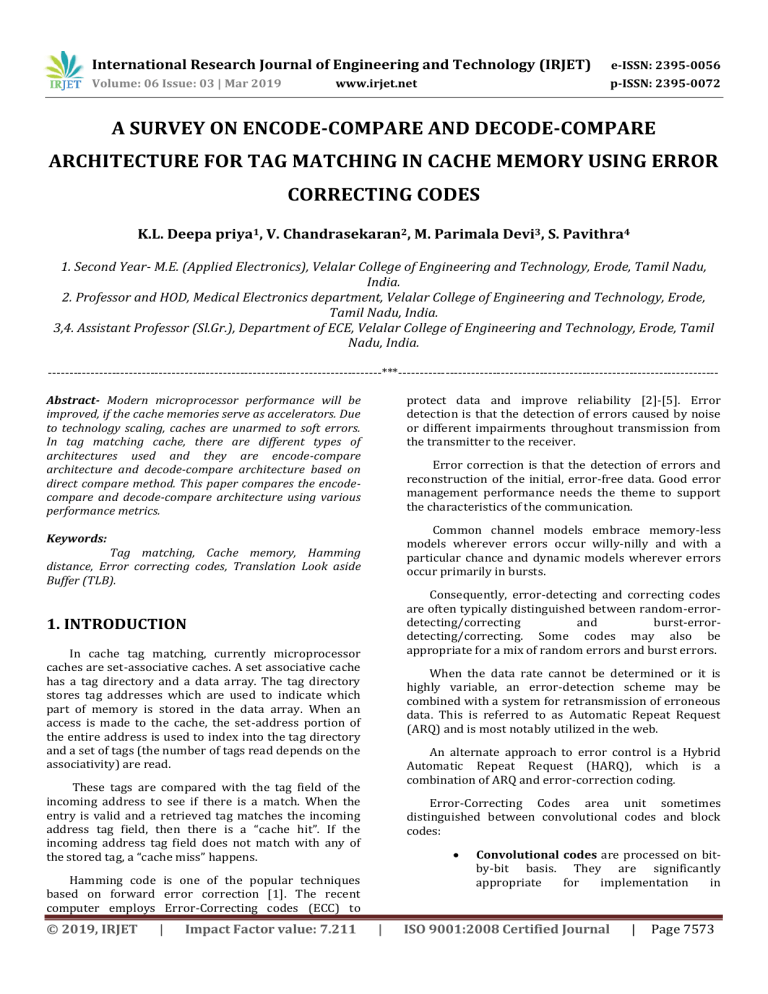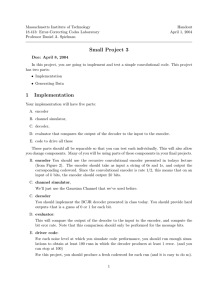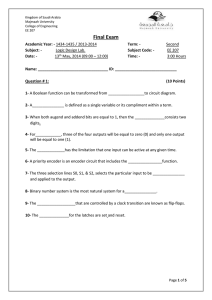IRJET-A Survey on Encode-Compare and Decode-Compare Architecture for Tag Matching in Cache Memory using Error Correcting Codes
advertisement

International Research Journal of Engineering and Technology (IRJET)
e-ISSN: 2395-0056
Volume: 06 Issue: 03 | Mar 2019
p-ISSN: 2395-0072
www.irjet.net
A SURVEY ON ENCODE-COMPARE AND DECODE-COMPARE
ARCHITECTURE FOR TAG MATCHING IN CACHE MEMORY USING ERROR
CORRECTING CODES
K.L. Deepa priya1, V. Chandrasekaran2, M. Parimala Devi3, S. Pavithra4
1. Second Year- M.E. (Applied Electronics), Velalar College of Engineering and Technology, Erode, Tamil Nadu,
India.
2. Professor and HOD, Medical Electronics department, Velalar College of Engineering and Technology, Erode,
Tamil Nadu, India.
3,4. Assistant Professor (Sl.Gr.), Department of ECE, Velalar College of Engineering and Technology, Erode, Tamil
Nadu, India.
------------------------------------------------------------------------------***--------------------------------------------------------------------------Abstract- Modern microprocessor performance will be
improved, if the cache memories serve as accelerators. Due
to technology scaling, caches are unarmed to soft errors.
In tag matching cache, there are different types of
architectures used and they are encode-compare
architecture and decode-compare architecture based on
direct compare method. This paper compares the encodecompare and decode-compare architecture using various
performance metrics.
protect data and improve reliability [2]-[5]. Error
detection is that the detection of errors caused by noise
or different impairments throughout transmission from
the transmitter to the receiver.
Error correction is that the detection of errors and
reconstruction of the initial, error-free data. Good error
management performance needs the theme to support
the characteristics of the communication.
Common channel models embrace memory-less
models wherever errors occur willy-nilly and with a
particular chance and dynamic models wherever errors
occur primarily in bursts.
Keywords:
Tag matching, Cache memory, Hamming
distance, Error correcting codes, Translation Look aside
Buffer (TLB).
Consequently, error-detecting and correcting codes
are often typically distinguished between random-errordetecting/correcting
and
burst-errordetecting/correcting. Some codes may also be
appropriate for a mix of random errors and burst errors.
1. INTRODUCTION
In cache tag matching, currently microprocessor
caches are set-associative caches. A set associative cache
has a tag directory and a data array. The tag directory
stores tag addresses which are used to indicate which
part of memory is stored in the data array. When an
access is made to the cache, the set-address portion of
the entire address is used to index into the tag directory
and a set of tags (the number of tags read depends on the
associativity) are read.
When the data rate cannot be determined or it is
highly variable, an error-detection scheme may be
combined with a system for retransmission of erroneous
data. This is referred to as Automatic Repeat Request
(ARQ) and is most notably utilized in the web.
An alternate approach to error control is a Hybrid
Automatic Repeat Request (HARQ), which is a
combination of ARQ and error-correction coding.
These tags are compared with the tag field of the
incoming address to see if there is a match. When the
entry is valid and a retrieved tag matches the incoming
address tag field, then there is a “cache hit”. If the
incoming address tag field does not match with any of
the stored tag, a “cache miss” happens.
Error-Correcting Codes area unit sometimes
distinguished between convolutional codes and block
codes:
Hamming code is one of the popular techniques
based on forward error correction [1]. The recent
computer employs Error-Correcting codes (ECC) to
© 2019, IRJET
|
Impact Factor value: 7.211
|
Convolutional codes are processed on bitby-bit basis. They are significantly
appropriate
for
implementation
in
ISO 9001:2008 Certified Journal
|
Page 7573
International Research Journal of Engineering and Technology (IRJET)
e-ISSN: 2395-0056
Volume: 06 Issue: 03 | Mar 2019
p-ISSN: 2395-0072
www.irjet.net
hardware and therefore the Viterbi decoder
permits best secret writing.
Block codes are processed on block-byblock basis. Repetition codes, hamming
codes and multi-dimensional parity-check
codes are the early examples of Block codes.
They were followed by variety of
economical codes, Reed–Solomon codes
being the most notable due to their current
widespread use. Turbo codes and LowDensity Parity-check Codes (LDPC) area unit
comparatively new constructions that may
offer nearly best potency.
Fig-1: (4,2) Saturation Adder
By logic reduction, the logic equation for this (4,
2) saturating adder is given by,
Carry=Ca +Cb+SaSb
2. BASIC DEFINITIONS
Sum=Sa +Sb+CaSa+CbSb
2.1 Hamming distance
2.3 Encoder
The Hamming distance between 2 strings of
equal length is that the range of positions at that the
corresponding symbols square measure totally different.
A simple encoder circuit can receive a single
active input out of 2n input lines and generate binary
code on n parallel output lines. For example, single bit 4
to 2 encoder takes in 4 bits and outputs 2 bits and it is
shown in Figure 2.
In a different way, it measures the minimum
range of substitutions needed to vary one string into the
opposite or the minimum range of errors that would
have reworked one string into the other.
Examples
The Hamming distance between:
"Karolin" and "Kathrin" is 3.
"Karolin" and "Kerstin" is 3.
1011101 and 1001001 is 2.
2173896 and 2233796 is 3.
2.2 Saturation adder
Saturation adder could be a version of
arithmetic during which all operations like addition and
multiplication are restricted to a set vary between a
minimum and most worth.
Fig-2: 4 to 2 Encoder
2.4 Decoder
It is a combinational circuit that converts the
binary information from n input lines to a maximum of
2n unique output lines and it is shown in Figure 3.
For example, if the valid vary of values is from -100
to one hundred, the subsequent operations manufacture
the subsequent values:
60 + 30 = 90
60 + 43 = 100
Figure 1 shows the (4, 2) saturation adder diagram.
© 2019, IRJET
|
Impact Factor value: 7.211
|
ISO 9001:2008 Certified Journal
|
Page 7574
International Research Journal of Engineering and Technology (IRJET)
e-ISSN: 2395-0056
Volume: 06 Issue: 03 | Mar 2019
p-ISSN: 2395-0072
www.irjet.net
The comparison is to look at what number bits
the 2 codewords dissent, not to check if the two
codewords are exactly equal to each other. For this, there
is a tendency to work out the overacting distance d
between the 2 codewords and classify the cases
consistent with the distance of ‘d’.
Let tmax and rmax denote the numbers of maximally
correctable and detectable errors, respectively. The
cases are summarized as follows.
Fig-3: 2 to 4 Decoder
3. ENCODE AND COMPARE
ARCHITECTURE
Assuming that the incoming address has no errors, 2
tags are regarded as matched if ‘d’ is in either the
primary or the second ranges. In this way, while
maintaining the error-correcting capability, the
architecture can remove the decoder from its critical
path at the cost of an encoder being newly introduced.
Decoding takes longer time than secret writing
because it encompasses a series of error detection or
syndrome calculation and error correction. To resolve
the drawbacks of the decode and compare architecture,
the decoding of a retrieved codeword is replaced with
the encoding of an incoming tag in the encode-andcompare architecture as shown in Figure 4.
Note that the encoder is, in general, much simpler
than the decoder, and thus the encoding cost is
significantly less than the decoding cost.
More precisely, a k-bit incoming tag is first
encoded in the corresponding n-bit codeword and
compared with the retrieved codeword as shown in
Figure 4.
Since the above method needs to compute the
Hamming distance, presented a circuit dedicated to the
computation.
Fig -5: SA based architecture supporting the direct
compare method
Fig -4: Encode and Compare Architecture
© 2019, IRJET
|
Impact Factor value: 7.211
If d = 0, X matches Y exactly.
If 0 <d ≤ tmax, X will match Y provided at most
tmax errors in Y are corrected.
If tmax<d ≤ rmax, Y has detectable but
uncorrectable errors. In this case, the cache may
issue a system fault, so as to make the central
processing unit take a proper action.
If rmax<d, X does not match Y
|
ISO 9001:2008 Certified Journal
|
Page 7575
International Research Journal of Engineering and Technology (IRJET)
e-ISSN: 2395-0056
Volume: 06 Issue: 03 | Mar 2019
p-ISSN: 2395-0072
www.irjet.net
The circuit shown in Figure 5 performs XOR
operations for each try of bits in X and Y thus on
generate a vector representing the bitwise distinction of
two codewords. The following half adder (HA) is used to
count the number of 1’s in two adjacent bits in the
vector.
decoder is one of the most complicated processing
elements, in addition, the complexity overhead is not
negligible. The decode compare architecture [8] is shown
in Figure 6.
5. DISCUSSION
The numbers of 1’s is accumulated by passing
through the following SA tree [6]. In the SA tree, the
accumulated value z is saturated to rmax+ 1 if it exceeds
rmax. More precisely, given inputs x and y, z can be
expressed as follows:
Results are discussed in the table shown below.
ENCODE-COMPARE
ARCHITECTURE
Encoder is simpler than
decoder
DECODE-COMPARE
ARCHITECTURE
Decoder is complex than
encoder
The final accumulated value indicates the range of d.
As the compulsory saturation necessitates additional
logic circuitry, the complexity of a SA is higher than the
conventional adder.
TheComplexity
overhead is negligible.
The Complexity
overhead is not
negligible.
4. DECODE AND COMPARE
ARCHITECTURE
In encode-compare
architecture, the
decoder is removed by
introducing an encoder.
For high speed access,
the decoder will
increase the critical
path.
Encoding cost is
significantly less.
Decoding cost is more.
{
(1)
A cache memory is considered where a k-bit tag is
stored in the form of an-bit codeword after being
encoded with a (n, k) code. In the decode-and-compare
architecture, the n-bit retrieved codeword should first be
decoded to extract the original k-bit tag. The extracted kbit tag is then compared to the k-bit tag field of an
incoming address to determine whether the tags are
matched or not.
6. CONCLUSION
Decoder is complex than encoder and the complexity
overhead is not negligible. Decoding cost is more than
encoding cost. Decoder will increase the critical path for
high speed access.
Encoder is simpler than decoder and the complexity
overhead is negligible. In Encode-compare architecture,
the decoder is removed by introducing an encoder.
Encoding cost is significantly less than decoding cost.
Comparing encoder and decoder architecture,
encoder architecture is the most efficient one and it has
less complexity and less cost.
REFERENCES
[1] Aswathi D and Keerthi Sahadevan, “An Efficient
Low Complexity Low Latency Architecture for
Matching of Data Encoded with Error Correcting
Code Using a Cache Memory”, Int. Journal of
Engineering Research and Application, Vol. 6,
Issue 10, (Part -3) October 2016, pp.82-85.
Fig -6: Decode and Compare Architecture
As the retrieved codeword should go through the
decoder before being compared with the incoming tag,
the critical path is too long to be employed in a practical
cache system designed for high-speed access. Since the
© 2019, IRJET
|
Impact Factor value: 7.211
|
ISO 9001:2008 Certified Journal
|
Page 7576
International Research Journal of Engineering and Technology (IRJET)
e-ISSN: 2395-0056
Volume: 06 Issue: 03 | Mar 2019
p-ISSN: 2395-0072
www.irjet.net
[2] Chang, J., Huang, M., Shoemaker, J., Benoit, J.,
Chen, S.L., Chen,W., Chiu, S., Ganesan, R., Leong,
G., Lukka, V., Rusu, S. and Srivastava, D.
(2007),''The 65-nm 16-MB shared on-die L3
cache for the dual-core Intel xeon Processor
7100 series'', IEEE J. Solid-state Circuits, Vol. 42,
No. 4, pp. 846–852.
[3] Warnock, J.D., Chan, Y. H., Carey, S.M., Wen, H.,
Meaney, P.J., Gerwig, G., Smith, H.H., Chan, Y.H.,
Davis, J., Bunce, P., Pelella, A., Rodko, D., Patel, P.,
Strach, T., Malone, D., Malgioglio, F., Neves, J.,
Rude, D.L. and Huott, W.V. (2012), ''Circuit and
physical design implementation of the
microprocessor
chip
for
the
Enterprisesystem'',IEEE J. Solid-state Circuits,
Vol. 47, No. 1, pp. 151–163.
[4] Ando, H., Yoshida, Y., Inoue, A., Sugiyama, I.,
Asakawa, T., Morita, K., Muta, T. And
Motokurumada, T., Okada, S., Yamashita, H., and
Satsukawa, Y. (2003), '' A 1.3 GHz fifth
generation
SPARC64
microprocessor'',IEEEISSCC. Dig. Tech. Papers,
pp. 246–247.
[5] Tremblay and M. Andchaudhry, S. (2008), ''A
third-generation 65nm 16-core 32-thread plus
32-Scout-thread CMT SPARC processor. ISSCC.
Dig. Tech. Papers, pp. 82–83.
[6] Wu, W., Somasekhar, D. and Lu, S.L. (2012),
''Direct compare of information coded with
error-correcting codes'', IEEE Trans. Very Large
Scale Integr. (VLSI) Syst., Vol. 20, No. 11, pp.
2147–2151.
[7] Pedro Reviriego, Salvatore Pontarelli, Juan
Antonio Maestro, and Marco Ottavi (2013), ''A
Method to Construct Low Delay Single Error
Correction Codes for Protecting Data Bits Only'',
IEEE Transactions on Computer-Aided Design of
Integrated Circuits and Systems, Vol. 32, No. 3.
[8] Mary Francy Joseph and Anith Mohan (2016),
''Improved Architecture for Tag Matching in
Cache memory Coded with Error Correcting
Codes'',
Global
Colloquium
in
Recent
Advancement and Effectual Researches in
Engineering, Science and Technology (RAEREST
2016), pp.544 – 551.
© 2019, IRJET
|
Impact Factor value: 7.211
|
ISO 9001:2008 Certified Journal
|
Page 7577






